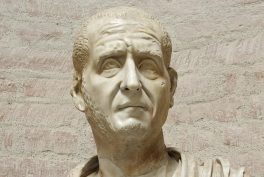The Late Roman Empire
During the later Roman Empire a remarkable artistic fusion occurred, blending classical Roman aesthetics with influences drawn from the diverse territories conquered by the empire. This period saw the emergence of a unique blend of artistic styles, marked by distinct characteristics such as elaborate mosaics, intricate relief sculptures, and the beginnings of Christian art.
These artistic expressions not only reflected the multicultural nature of the Roman Empire but also hinted at the evolving spiritual and cultural landscape during this transformative era.
The Rise of Christian Art
The ascent of Christianity as a dominant religious force was one of the most significant events during the decline of Rome. This period saw a monumental shift from pagan beliefs to Christianity and was reflected in the realm of art.
These artistic expressions shifted from showcasing the grandeur of the imperial past to a fervent devotion to the growing Christian faith, encapsulating the evolving spiritual landscape of the era.
Churches supplanted ancient temples and palaces. Therefore frescoes and murals began to depict intricate biblical scenes instead of the mythological motifs favored in previous centuries.
The End of Patronage
As the Roman Empire faced its inexorable decline, resources dwindled, and with them, the patronage for art and culture. Both private and public funds for artistic endeavors began to recede. Also large-scale construction projects that once defined the empire’s power and architectural splendor became increasingly scarce.
This naturally resulted in economic hardships for artists of the period who no longer had the steady employment or opportunities of their predecessors. They had to adapt to the changing landscape by evolving to create more portable works of art such as intricate jewelry, coinage, and other decorative personal items.
Byzantine Art
Although the Western Roman Empire met its demise in 476 CE, the Eastern Roman Empire, also known as the Byzantine Empire, persevered for several more centuries. This period saw the rise of Byzantine art which emerged as a continuation of the cherished Roman artistic traditions that were infused with distinct Eastern influences.
Evolution
Art during the Fall of Rome served as a reflection of the empire’s decline, as well as a bridge between the past and the future. Although the Fall of Rome marked the end of an era, neither life nor art came to a standstill. Instead, the decline spurred artistic transformations that encompassed the birth of new artistic expressions from the influence of the East, and the ascent of Christian art as a dominant force. These changes in artistic expression and style laid the foundation for subsequent periods including the Renaissance that carried forward the legacy of Rome while evolving in its own distinct way.














